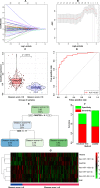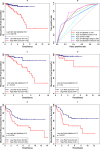A Three-Gene Classifier Associated With MicroRNA-Mediated Regulation Predicts Prostate Cancer Recurrence After Radical Prostatectomy
- PMID: 32117427
- PMCID: PMC7011265
- DOI: 10.3389/fgene.2019.01402
A Three-Gene Classifier Associated With MicroRNA-Mediated Regulation Predicts Prostate Cancer Recurrence After Radical Prostatectomy
Abstract
Background and objective: After radical prostatectomy (RP), prostate cancer (PCa) patients may experience biochemical recurrence (BCR) and clinical recurrence, which remains a dominant issue in PCa treatment. The purpose of this study was to identify a protein-coding gene classifier associated with microRNA (miRNA)-mediated regulation to provide a comprehensive prognostic index to predict PCa recurrence after RP.
Methods: Candidate classifiers were constructed using two machine-learning algorithms (a least absolute shrinkage and selector operation [LASSO]-based classifier and a decision tree-based classifier) based on a discovery cohort (n = 156) from The Cancer Genome Atlas (TCGA) database. After selecting the LASSO-based classifier based on the prediction accuracy, both an internal validation cohort (n = 333) and an external validation cohort (n = 100) were used to examined the classifier using survival analysis, time-dependent receiver operating characteristic (ROC) curve analysis, and univariate and multivariate Cox proportional hazards regression analyses. Functional enrichment analysis of co-expressed genes was carried out to explore the underlying moleculer mechanisms of the genes included in the classifier.
Results: We constructed a three-gene classifier that included FAM72B, GNE, and TRIM46, and we identified four upstream prognostic miRNAs (hsa-miR-133a-3p, hsa-miR-222-3p, hsa-miR-1301-3p, and hsa-miR-30c-2-3p). The classifier exhibited a remarkable ability (area under the curve [AUC] = 0.927) to distinguish PCa patients with high and low Gleason scores in the discovery cohort. Furthermore, it was significantly associated with clinical recurrence (p < 0.0001, log rank statistic = 20.7, AUC = 0.733) and could serve as an independent prognostic factor of recurrence-free survival (hazard ratio: 1.708, 95% CI: 1.180-2.472, p < 0.001). Additionally, it was a predictor of BCR according to BCR-free survival analysis (p = 0.0338, log rank statistic = 4.51).
Conclusions: The three-gene classifier associated with miRNA-mediated regulation may serve as a novel prognostic biomarker for PCa patients after RP.
Keywords: biochemical recurrence; clinical recurrence; microRNA; prostate cancer; protein-coding gene classifier; radical prostatectomy.
Copyright © 2020 Cheng, He, Cheng, Yang, Pei, Deng, Long, Zhu and Jiang.
Figures






References
-
- Abou-Ouf H., Alshalalfa M., Takhar M., Erho N., Donnelly B., Davicioni E., et al. (2018). Validation of a 10-gene molecular signature for predicting biochemical recurrence and clinical metastasis in localized prostate cancer. J. Cancer Res. Clin. Oncol. 144, 883–891. 10.1007/s00432-018-2615-7 - DOI - PMC - PubMed
LinkOut - more resources
Full Text Sources

